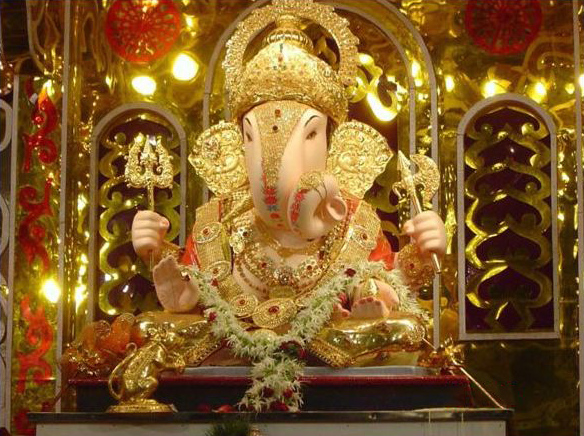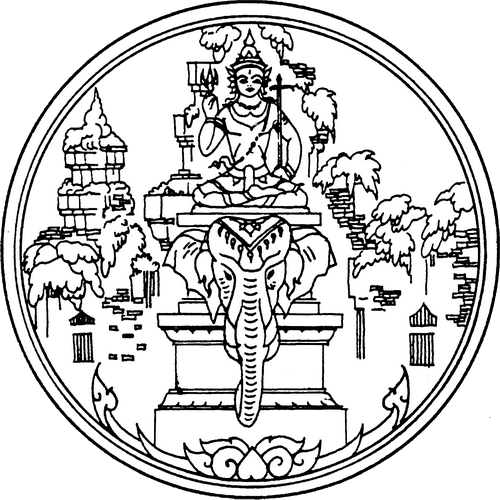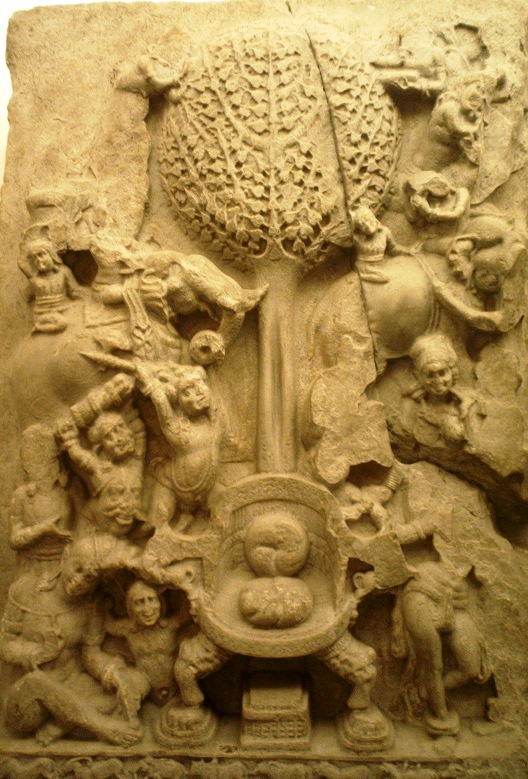|
Linga
A lingam ( , lit. "sign, symbol or mark"), sometimes referred to as linga or Shiva linga, is an abstract or aniconic representation of the Hindu god Shiva in Shaivism. The word ''lingam'' is found in the Upanishads and epic literature, where it means a "mark, sign, emblem, characteristic", the "evidence, proof, symptom" of Shiva and Shiva's power. The lingam of the Shaivism tradition is a short cylindrical pillar-like symbol of Shiva, made of stone, metal, gem, wood, clay or precious stones. It is often represented within a disc-shaped platform, the '' yoni'' – its feminine counterpart, consisting of a flat element, horizontal compared to the vertical lingam, and designed to allow liquid offerings to drain away for collection. The ''lingam'' is an emblem of generative and destructive power. While rooted in representations of the male sexual organ, the ''lingam'' is regarded as the "outward symbol" of the "formless reality", the symbolization of merging of the 'primordial ... [...More Info...] [...Related Items...] OR: [Wikipedia] [Google] [Baidu] |
Shiva
Shiva (; , ), also known as Mahadeva (; , , Help:IPA/Sanskrit, [mɐɦaːd̪eːʋɐh]) and Hara, is one of the Hindu deities, principal deities of Hinduism. He is the God in Hinduism, Supreme Being in Shaivism, one of the major traditions within Hinduism. Shiva is known as ''The Destroyer'' within the Trimurti, the Hinduism, Hindu trinity which also includes Brahma and Vishnu. In the Shaivite tradition, Shiva is the Supreme Lord who creates, protects and transforms the universe. In the goddess-oriented Shaktism, Shakta tradition, the Supreme Goddess (Devi) is regarded as the energy and creative power (Shakti) and the equal complementary partner of Shiva. Shiva is one of the five equivalent deities in Panchayatana puja of the Smarta Tradition, Smarta tradition of Hinduism. Shiva has many aspects, benevolent as well as fearsome. In benevolent aspects, he is depicted as an Omniscience, omniscient yogi who lives an Asceticism#Hinduism, ascetic life on Kailasa as well as a house ... [...More Info...] [...Related Items...] OR: [Wikipedia] [Google] [Baidu] |
Shaivism
Shaivism (, , ) is one of the major Hindu denominations, Hindu traditions, which worships Shiva as the Para Brahman, supreme being. It is the Hinduism#Demographics, second-largest Hindu sect after Vaishnavism, constituting about 385 million Hindus, found widely across South Asia (predominantly in South India, Southern India), Sri Lanka, and Nepal.Keay, p.xxvii. The followers of Shaivism are called Shaivas or Shaivites. According to Chakravarti, Shaivism developed as an amalgam of pre-Aryan religions and traditions, Vedic Rudra, and post-Vedic traditions, accommodating local traditions and Yoga, puja and bhakti. According to Bisschop, early shaivism is rooted in the worship of vedic deity Rudra. The earliest evidence for sectarian Rudra-Shiva worship appears with the Pasupata (early CE), possibly owing to the Origins of Hinduism, Hindu synthesis, when many local traditions were aligned with the Brahmanism, Vedic-Brahmanical fold. The Pāśupata movement rapidly expanded through ... [...More Info...] [...Related Items...] OR: [Wikipedia] [Google] [Baidu] |
Yoni
''Yoni'' (Sanskrit: योनि, ), sometimes called ''pindika'', is an abstract or aniconic representation of the Hindu goddess Shakti. It is usually shown with ''linga'' – its masculine counterpart. Together, they symbolize the merging of microcosmos and macrocosmos, the divine eternal process of creation and regeneration, and the union of the feminine and the masculine that recreates all of existence. The ''yoni'' is conceptualized as nature's gateway of all births, particularly in the esoteric Kaula and Tantra practices, as well as the Shaktism and Shaivism traditions of Hinduism. ''Yoni'' is a Sanskrit word that has been interpreted to literally mean the "womb", the "source", and the female organs of generation., Quote: "Yoni- 'womb, vulva', Yoni- "way, abode' is from a second PIE root ..; It also connotes the female sexual organs such as "vagina", "vulva", and "uterus", or alternatively to "origin, abode, or source" of anything in other contexts. For example, the V ... [...More Info...] [...Related Items...] OR: [Wikipedia] [Google] [Baidu] |
Hindu Temple
A Hindu temple, also known as Mandir, Devasthanam, Pura, or Kovil, is a sacred place where Hindus worship and show their devotion to Hindu deities, deities through worship, sacrifice, and prayers. It is considered the house of the god to whom it is dedicated.; Quote: "The Hindu temple is designed to bring about contact between man and the gods of Hinduism religion" (...) "The architecture of the Hindu temple symbolically represents this quest by setting out to dissolve or decrease the boundaries between man and the divine". Hindu temple architecture, which makes extensive use of squares and circles, has its roots in later Vedic traditions, which also influence the temples' construction and symbolism. Through astronomical numbers and particular alignments connected to the temple's location and the relationship between the deity and the worshipper, the temple's design also illustrates the idea of recursion and the Microcosm–macrocosm analogy, equivalency of the macrocosm and t ... [...More Info...] [...Related Items...] OR: [Wikipedia] [Google] [Baidu] |
Hinduism
Hinduism () is an Hypernymy and hyponymy, umbrella term for a range of Indian religions, Indian List of religions and spiritual traditions#Indian religions, religious and spiritual traditions (Sampradaya, ''sampradaya''s) that are unified by adherence to the concept of ''dharma'', a Ṛta, cosmic order maintained by its followers through rituals and righteous living, as expounded in the Vedas. The word ''Hindu'' is an exonym, and while Hinduism has been called the oldest religion in the world, it has also been described by the modern term ''Sanātana Dharma'' () emphasizing its eternal nature. ''Vaidika Dharma'' () and ''Arya dharma'' are historical endonyms for Hinduism. Hinduism entails diverse systems of thought, marked by a range of shared Glossary of Hinduism terms, concepts that discuss God in Hinduism, theology, Hindu mythology, mythology, among other topics in Hindu texts, textual sources. Hindu texts have been classified into Śruti () and Smṛti (). The major Hin ... [...More Info...] [...Related Items...] OR: [Wikipedia] [Google] [Baidu] |
Murti
In the Hinduism, Hindu tradition, a ''murti'' (, ) is a devotional image, such as a statue or icon, of a Hindu deities, deity or Hindu saints, saint used during ''Puja (Hinduism), puja'' and/or in other customary forms of actively expressing devotion or reverence – whether at Hindu temples or shrines. A ''mūrti'' is a symbolic icon representing divinity for the purpose of devotional activities. Thus, not all icons of gods and saints are ''mūrti''; for example, purely decorative depictions of divine figures often adorn Hindu temple architecture in intricately carved doorframes, on colourfully painted walls, and ornately sculpted rooftop domes. A ''mūrti'' itself is not God, but it is merely a representative shape, symbolic embodiment, or iconic manifestation of God. ''Murti'' are also found in some nontheistic Jainism, Jain traditions, where they serve as symbols of revered mortals inside Jain temples, and are worshiped in ''murtipujaka'' rituals. A ''murti'' is typically ... [...More Info...] [...Related Items...] OR: [Wikipedia] [Google] [Baidu] |
Svayambhu
Svayambhu () is a Sanskrit word that means "self-born", "self-manifested", "self-existing", or "that that is created by its own accord". Various deities and entities featured in Hindu literature and tradition are regarded to be svayambhu, such as Brahman in the Upanishads, and the Trimurti of Brahma, Vishnu, and Shiva, and Manu in the Puranas. The term svayambhu is also used to describe the belief of a self-manifested image (''murti'') of a deity present in a temple, which is described to be not of human creation, but of natural or divine origin. Such images are described in some of the regional legends of religious sites called the sthala puranas. Some of the best examples of such images include the twelve Jyotirlinga images of Shiva, and Venkateswara image of Vishnu. Etymology Svayambhu is a portmanteau of the Sanskrit words ''svayam'' (स्वयम्) which means 'self' or 'on its own' and ''bhū'' (भू) which means 'to take birth' or 'arising'. Literature ... [...More Info...] [...Related Items...] OR: [Wikipedia] [Google] [Baidu] |
Cult Image
In the practice of religion, a cult image is a Cultural artifact, human-made object that is venerated or worshipped for the deity, Spirit (supernatural entity), spirit or Daimon, daemon that it embodies or represents. In several traditions, including the ancient religions of Ancient Egypt, Egypt, Ancient Greece, Greece and Rome, and Hinduism, cult images in a temple may undergo a daily routine of being washed, dressed, and having food left for them. Processions outside the temple on special feast days are often a feature. Religious images cover a wider range of all types of images made with a religious purpose, subject, or connection. In many contexts "cult image" specifically means the most important image in a temple, kept in an inner space, as opposed to what may be many other images decorating the temple. The term idol is an image or representation of a god used as an object of worship, while idolatry is the worship of an "idol" as though it were God. Ancient Near East and E ... [...More Info...] [...Related Items...] OR: [Wikipedia] [Google] [Baidu] |
Hindu Deities
Hindu deities are the gods and goddesses in Hinduism. Deities in Hinduism are as diverse as its traditions, and a Hindu can choose to be polytheistic, pantheistic, monotheistic, monistic, even agnostic, atheistic, or humanist. Julius J. Lipner (2009), Hindus: Their Religious Beliefs and Practices, 2nd edition, Routledge, , p. 8; Quote: "(...) one need not be religious in the minimal sense described to be accepted as a Hindu by Hindus, or describe oneself perfectly validly as Hindu. One may be polytheistic or monotheistic, monistic or pantheistic, even an agnostic, humanist or atheist, and still be considered a Hindu." The terms and epithets for deities within the diverse traditions of Hinduism vary, and include Deva, Devi, Ishvara, Ishvari, Bhagavān and Bhagavati. The deities of Hinduism have evolved from the Vedic era (2nd millennium BCE) through the medieval era (1st millennium CE), regionally within Nepal, Pakistan, India and in Southeast Asia, and across Hinduism ... [...More Info...] [...Related Items...] OR: [Wikipedia] [Google] [Baidu] |
Aniconism
Aniconism is the cultural absence of artistic representations ('' icons'') of the natural and supernatural worlds, or it is the absence of representations of certain figures in religions. The prohibition of material representations may only extend to a specific supreme deity, or it can encompass an entire pantheon, it can also include depictions of a prophet, saints, or sages, or even depictions of living beings and anything in existence generally. It is generally codified by religious traditions and as such, it becomes a taboo. When it is enforced by the physical destruction of images, aniconism becomes iconoclasm. Aniconism has historical phases in both Buddhism and Christianity, though these movements have been largely rejected as Buddha in art, life of Buddha in art, Buddhas and bodhisattvas in art, God the Father in Western art, Holy Spirit in Christian art, the depiction of Jesus, The Trinity in art, and are common. By contrast Aniconism in Islam, Islam has predomin ... [...More Info...] [...Related Items...] OR: [Wikipedia] [Google] [Baidu] |
Indian Epic Poetry
Indian epic poetry is the epic poetry written in the Indian subcontinent, traditionally called ''Kavya'' (or ''Kāvya''; Sanskrit: काव्य, IAST: ''kāvyá''). The ''Ramayana'' and the '' Mahabharata'', which were originally composed in Sanskrit and later translated into many other Indian languages, and the Five Great Epics of Tamil literature and Sangam literature are some of the oldest surviving epic poems ever written. List of longest epics Hindi epics In modern Hindi literature, '' Kamayani'' by Jaishankar Prasad has attained the status of an epic. The narrative of Kamayani is based on a popular mythological story, first mentioned in Satapatha Brahmana. It is a story of the great flood and the central characters of the epic poem are Manu (a male) and Shraddha (a female). Manu is representative of the human psyche and Shradha represents love. Another female character is Ida, who represents rationality. Some critics surmise that the three lead characters o ... [...More Info...] [...Related Items...] OR: [Wikipedia] [Google] [Baidu] |
Three Bodies Doctrine
According to three bodies doctrine in Hinduism, the human being is composed of three ''shariras'' or "bodies" emanating from Brahman by avidya, "ignorance" or "nescience". They are often equated with the five koshas (sheaths), which cover the atman. This doctrine is an essential doctrine in Indian philosophy and religion, especially Yoga, Advaita Vedanta, Tantra and Shaivism. The three bodies Karana sarira – causal body ''Karana sarira'' or the causal body is merely the cause or seed of the subtle body and the gross body. It has no other function than being the seed of the subtle and the gross body. It is ''nirvikalpa rupam'', "undifferentiated form". It originates with ''avidya'', "ignorance" or "nescience" of the real identity of the atman, instead giving birth to the notion of ''jiva''. Swami Sivananda characterizes the causal body as "The beginningless ignorance that is indescribable". Siddharameshwar Maharaj, the guru of Nisargadatta Maharaj, also describes the ca ... [...More Info...] [...Related Items...] OR: [Wikipedia] [Google] [Baidu] |








